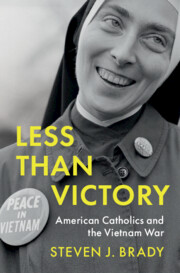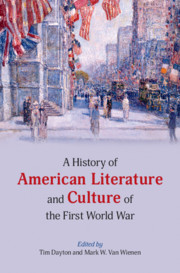Refine search
Actions for selected content:
13 results
Epilogue
-
- Book:
- Waging Peace
- Published online:
- 03 November 2025
- Print publication:
- 13 November 2025, pp 408-414
-
- Chapter
- Export citation
3 - Organized Anarchy (1966)
-
- Book:
- Waging Peace
- Published online:
- 03 November 2025
- Print publication:
- 13 November 2025, pp 80-118
-
- Chapter
- Export citation
2 - The War Within (1965)
-
- Book:
- Waging Peace
- Published online:
- 03 November 2025
- Print publication:
- 13 November 2025, pp 39-79
-
- Chapter
- Export citation
Introduction
-
- Book:
- Waging Peace
- Published online:
- 03 November 2025
- Print publication:
- 13 November 2025, pp 1-7
-
- Chapter
- Export citation

Waging Peace
- A History of the Vietnam Antiwar Movement
-
- Published online:
- 03 November 2025
- Print publication:
- 13 November 2025

Less Than Victory
- American Catholics and the Vietnam War
-
- Published online:
- 16 October 2025
- Print publication:
- 11 September 2025
4 - “It Must Be Nice to Be That Sure”: July 1965–December 1966
-
- Book:
- Less Than Victory
- Published online:
- 16 October 2025
- Print publication:
- 11 September 2025, pp 103-140
-
- Chapter
- Export citation

Protest and Policy in the Iraq, Nuclear Freeze and Vietnam Peace Movements
-
- Published online:
- 19 May 2025
- Print publication:
- 19 June 2025
-
- Element
- Export citation
24 - International Radicalism and Antiwar Protest
- from Part III - Global Vietnam
-
-
- Book:
- The Cambridge History of the Vietnam War
- Published online:
- 02 January 2025
- Print publication:
- 28 November 2024, pp 509-528
-
- Chapter
- Export citation
30 - Vietnam and the Global 1968
- from Part III - Global Vietnam
-
-
- Book:
- The Cambridge History of the Vietnam War
- Published online:
- 02 January 2025
- Print publication:
- 28 November 2024, pp 648-664
-
- Chapter
- Export citation
Chapter 17 - War and Humanitarianism
- from Part III - Emerging Concepts
-
-
- Book:
- War and Literary Studies
- Published online:
- 15 January 2023
- Print publication:
- 05 January 2023, pp 278-292
-
- Chapter
- Export citation
Chapter 9 - The Peace Movement
- from Part II - Settings and Subjects
-
-
- Book:
- A History of American Literature and Culture of the First World War
- Published online:
- 23 January 2021
- Print publication:
- 04 February 2021, pp 141-152
-
- Chapter
- Export citation

A History of American Literature and Culture of the First World War
-
- Published online:
- 23 January 2021
- Print publication:
- 04 February 2021
